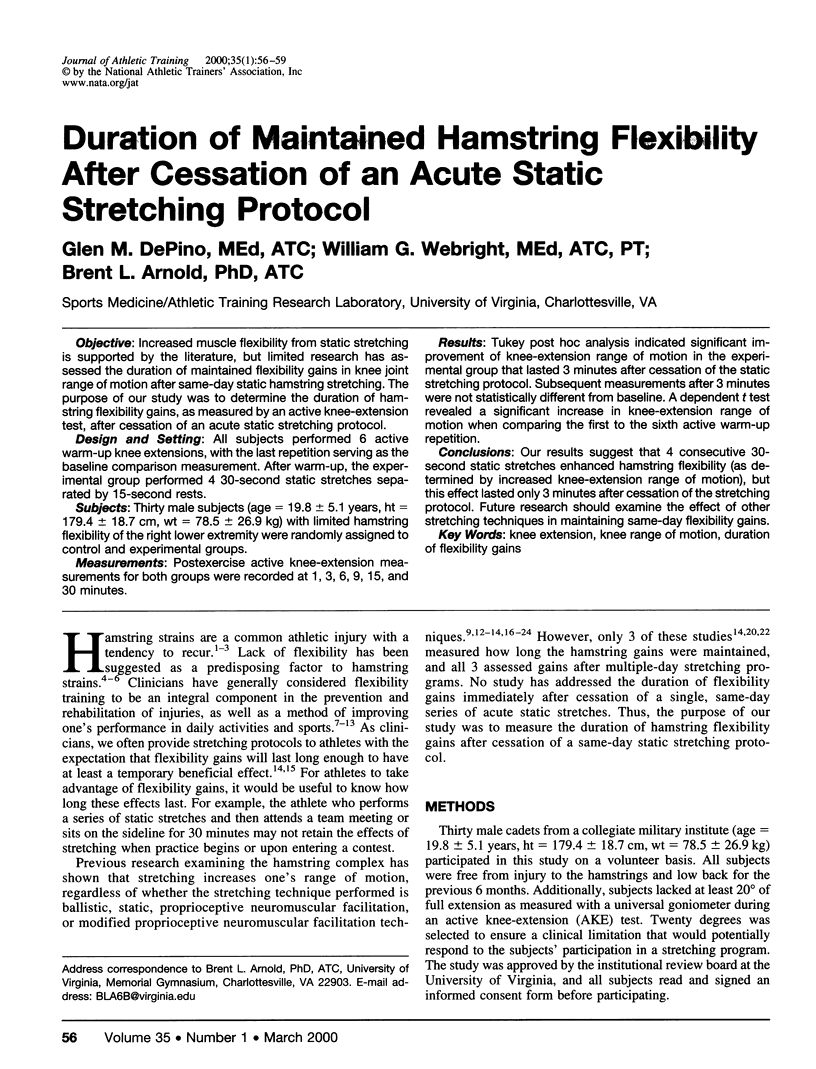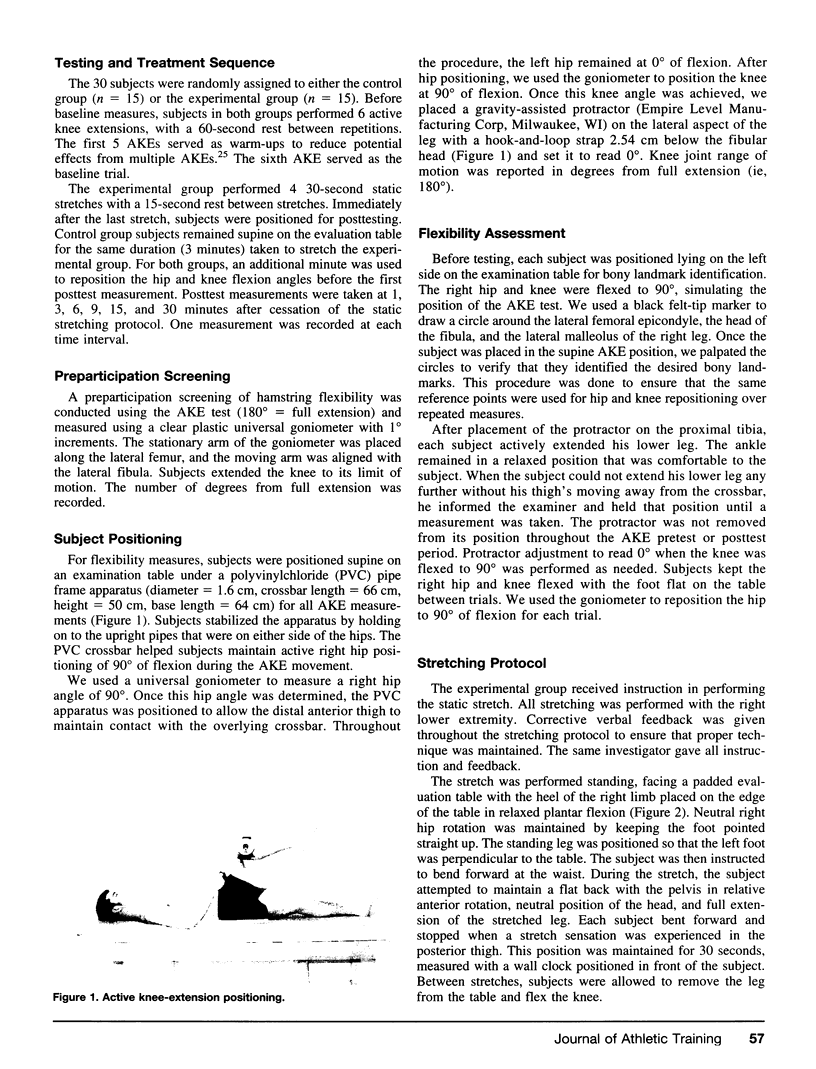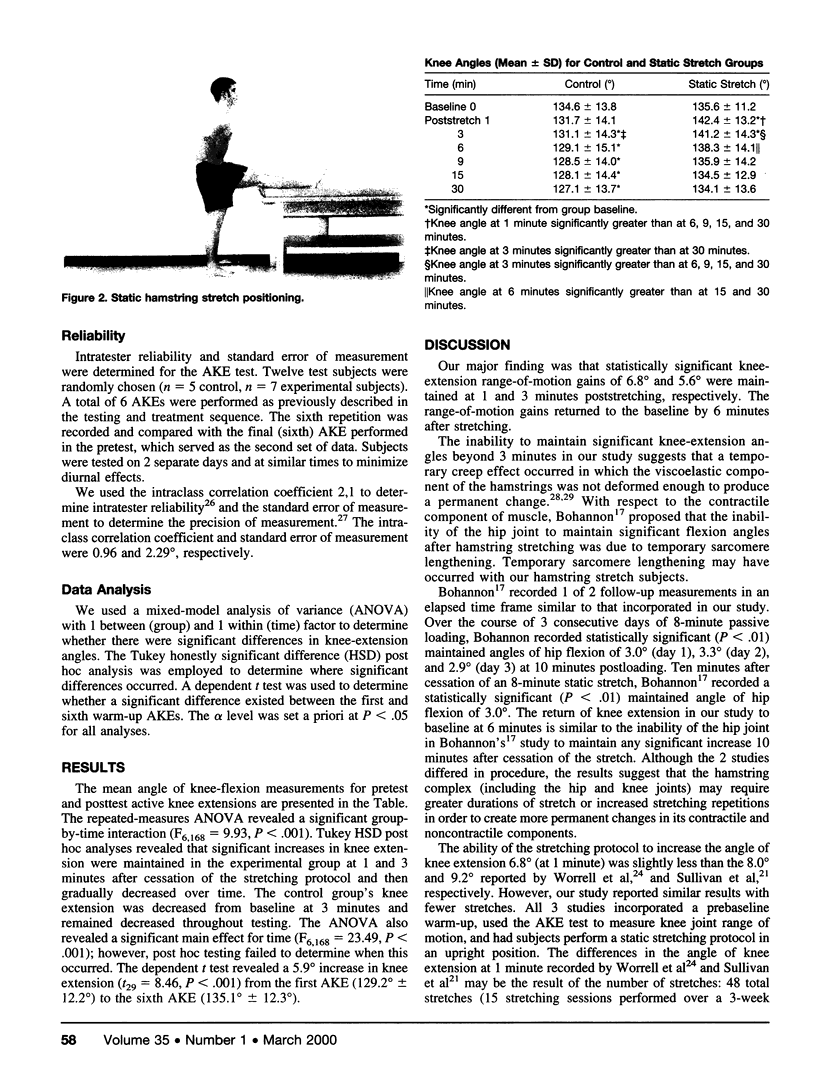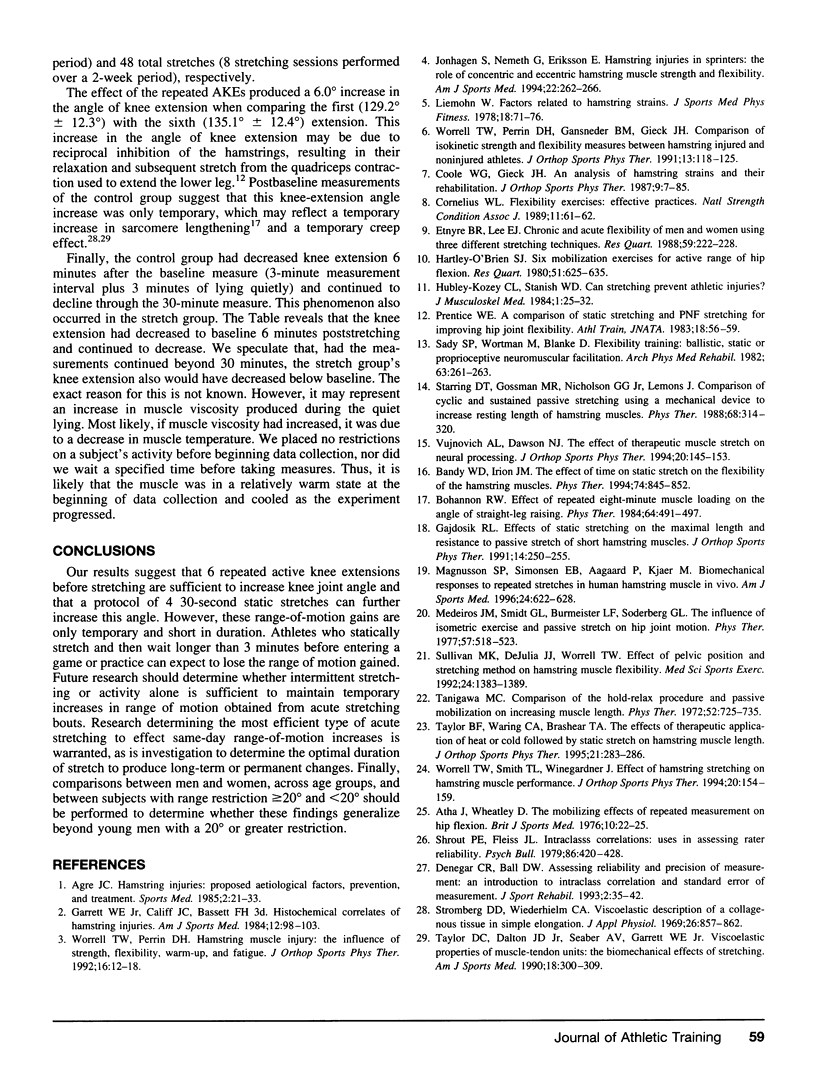Abstract
Objective:
Increased muscle flexibility from static stretching is supported by the literature, but limited research has assessed the duration of maintained flexibility gains in knee joint range of motion after same-day static hamstring stretching. The purpose of our study was to determine the duration of hamstring flexibility gains, as measured by an active knee-extension test, after cessation of an acute static stretching protocol.
Design and Setting:
All subjects performed 6 active warm-up knee extensions, with the last repetition serving as the baseline comparison measurement. After warm-up, the experimental group performed 4 30-second static stretches separated by 15-second rests.
Subjects:
Thirty male subjects (age = 19.8 ± 5.1 years, ht = 179.4 ± 18.7 cm, wt = 78.5 ± 26.9 kg) with limited hamstring flexibility of the right lower extremity were randomly assigned to control and experimental groups.
Measurements:
Postexercise active knee-extension measurements for both groups were recorded at 1, 3, 6, 9, 15, and 30 minutes.
Results:
Tukey post hoc analysis indicated significant improvement of knee-extension range of motion in the experimental group that lasted 3 minutes after cessation of the static stretching protocol. Subsequent measurements after 3 minutes were not statistically different from baseline. A dependent t test revealed a significant increase in knee-extension range of motion when comparing the first to the sixth active warm-up repetition.
Conclusions:
Our results suggest that 4 consecutive 30-second static stretches enhanced hamstring flexibility (as determined by increased knee-extension range of motion), but this effect lasted only 3 minutes after cessation of the stretching protocol. Future research should examine the effect of other stretching techniques in maintaining same-day flexibility gains.
Keywords: knee extension, knee range of motion, duration of flexibility gains
Full text
PDF



Images in this article
Selected References
These references are in PubMed. This may not be the complete list of references from this article.
- Agre J. C. Hamstring injuries. Proposed aetiological factors, prevention, and treatment. Sports Med. 1985 Jan-Feb;2(1):21–33. doi: 10.2165/00007256-198502010-00003. [DOI] [PubMed] [Google Scholar]
- Atha J., Wheatley D. W. The mobilising effects of repeated measurement on hip flexion. Br J Sports Med. 1976 Mar;10(1):22–25. doi: 10.1136/bjsm.10.1.22. [DOI] [PMC free article] [PubMed] [Google Scholar]
- Bandy W. D., Irion J. M. The effect of time on static stretch on the flexibility of the hamstring muscles. Phys Ther. 1994 Sep;74(9):845–852. doi: 10.1093/ptj/74.9.845. [DOI] [PubMed] [Google Scholar]
- Bohannon R. W. Effect of repeated eight-minute muscle loading on the angle of straight-leg raising. Phys Ther. 1984 Apr;64(4):491–497. doi: 10.1093/ptj/64.4.491. [DOI] [PubMed] [Google Scholar]
- Garrett W. E., Jr, Califf J. C., Bassett F. H., 3rd Histochemical correlates of hamstring injuries. Am J Sports Med. 1984 Mar-Apr;12(2):98–103. doi: 10.1177/036354658401200202. [DOI] [PubMed] [Google Scholar]
- Hartley-O'Brien S. J. Six mobilization exercises for active range of hip flexion. Res Q Exerc Sport. 1980 Dec;51(4):625–635. doi: 10.1080/02701367.1980.10609323. [DOI] [PubMed] [Google Scholar]
- Jönhagen S., Németh G., Eriksson E. Hamstring injuries in sprinters. The role of concentric and eccentric hamstring muscle strength and flexibility. Am J Sports Med. 1994 Mar-Apr;22(2):262–266. doi: 10.1177/036354659402200218. [DOI] [PubMed] [Google Scholar]
- Liemohn W. Factors related to hamstring strains. J Sports Med Phys Fitness. 1978 Mar;18(1):71–76. [PubMed] [Google Scholar]
- Magnusson S. P., Simonsen E. B., Aagaard P., Kjaer M. Biomechanical responses to repeated stretches in human hamstring muscle in vivo. Am J Sports Med. 1996 Sep-Oct;24(5):622–628. doi: 10.1177/036354659602400510. [DOI] [PubMed] [Google Scholar]
- Medeiros J. M., Smidt G. L., Burmeister L. F., Soderberg G. L. The influence of isometric exercise and passive stretch on hip joint motion. Phys Ther. 1977 May;57(5):518–523. doi: 10.1093/ptj/57.5.518. [DOI] [PubMed] [Google Scholar]
- Sady S. P., Wortman M., Blanke D. Flexibility training: ballistic, static or proprioceptive neuromuscular facilitation? Arch Phys Med Rehabil. 1982 Jun;63(6):261–263. [PubMed] [Google Scholar]
- Starring D. T., Gossman M. R., Nicholson G. G., Jr, Lemons J. Comparison of cyclic and sustained passive stretching using a mechanical device to increase resting length of hamstring muscles. Phys Ther. 1988 Mar;68(3):314–320. doi: 10.1093/ptj/68.3.314. [DOI] [PubMed] [Google Scholar]
- Stromberg D. D., Wiederhielm C. A. Viscoelastic description of a collagenous tissue in simple elongation. J Appl Physiol. 1969 Jun;26(6):857–862. doi: 10.1152/jappl.1969.26.6.857. [DOI] [PubMed] [Google Scholar]
- Sullivan M. K., Dejulia J. J., Worrell T. W. Effect of pelvic position and stretching method on hamstring muscle flexibility. Med Sci Sports Exerc. 1992 Dec;24(12):1383–1389. [PubMed] [Google Scholar]
- Tanigawa M. C. Comparison of the hold-relax procedure and passive mobilization on increasing muscle length. Phys Ther. 1972 Jul;52(7):725–735. doi: 10.1093/ptj/52.7.725. [DOI] [PubMed] [Google Scholar]
- Taylor B. F., Waring C. A., Brashear T. A. The effects of therapeutic application of heat or cold followed by static stretch on hamstring muscle length. J Orthop Sports Phys Ther. 1995 May;21(5):283–286. doi: 10.2519/jospt.1995.21.5.283. [DOI] [PubMed] [Google Scholar]
- Taylor D. C., Dalton J. D., Jr, Seaber A. V., Garrett W. E., Jr Viscoelastic properties of muscle-tendon units. The biomechanical effects of stretching. Am J Sports Med. 1990 May-Jun;18(3):300–309. doi: 10.1177/036354659001800314. [DOI] [PubMed] [Google Scholar]
- Vujnovich A. L., Dawson N. J. The effect of therapeutic muscle stretch on neural processing. J Orthop Sports Phys Ther. 1994 Sep;20(3):145–153. doi: 10.2519/jospt.1994.20.3.145. [DOI] [PubMed] [Google Scholar]
- Worrell T. W., Smith T. L., Winegardner J. Effect of hamstring stretching on hamstring muscle performance. J Orthop Sports Phys Ther. 1994 Sep;20(3):154–159. doi: 10.2519/jospt.1994.20.3.154. [DOI] [PubMed] [Google Scholar]




